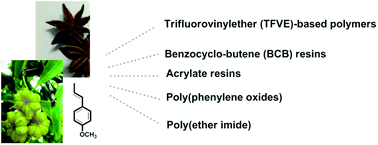当前位置:
X-MOL 学术
›
Polym. Chem.
›
论文详情
Our official English website, www.x-mol.net, welcomes your feedback! (Note: you will need to create a separate account there.)
Biomass materials derived from anethole: conversion and application
Polymer Chemistry ( IF 4.6 ) Pub Date : 2019/12/17 , DOI: 10.1039/c9py01513b Caiyun Wang 1, 2, 3, 4, 5 , Jing Sun 5, 6, 7, 8, 9 , Yangqing Tao 5, 6, 7, 8, 9 , Linxuan Fang 5, 6, 7, 8, 9 , Junfeng Zhou 5, 6, 7, 8, 9 , Menglu Dai 5, 6, 7, 8, 9 , Meina Liu 1, 2, 3, 4 , Qiang Fang 5, 6, 7, 8, 9
Polymer Chemistry ( IF 4.6 ) Pub Date : 2019/12/17 , DOI: 10.1039/c9py01513b Caiyun Wang 1, 2, 3, 4, 5 , Jing Sun 5, 6, 7, 8, 9 , Yangqing Tao 5, 6, 7, 8, 9 , Linxuan Fang 5, 6, 7, 8, 9 , Junfeng Zhou 5, 6, 7, 8, 9 , Menglu Dai 5, 6, 7, 8, 9 , Meina Liu 1, 2, 3, 4 , Qiang Fang 5, 6, 7, 8, 9
Affiliation

|
Renewable biomass has been attracting extensive attention because of its advantages over fossil fuels, including renewability, ready availability and abundance. Anethole, as a kind of aromatic inedible plant oil, has been converted to various functional materials by skillful designing and preparation. As for the chemical structure of anethole, the propenyl group enables anethole not only to co-polymerize with electro-deficient monomers by the initiation of free radicals, but also to undergo cationic copolymerization to form oligomers. The methoxy group enables anethole to be functionalized by other groups. Because of its high reactivity, anethole has been developed as a reliable monomer or precursor for diverse materials with potential applications, such as microsphere adsorbents, dielectric materials, and high-performance polymers. The results show that anethole is a promising candidate for replacement of petroleum-based raw materials. This review summarizes the chemical conversions and applications of anethole, which may offer some inspiration for the application of other biomass materials widely existing in or extracted from nature.
中文翻译:

茴香脑衍生的生物质材料:转化与应用
可再生生物质因其比化石燃料具有的优势而受到广泛关注,包括可再生性,可利用性和丰富性。茴香脑,作为一种芳香族不可食用的植物油,通过精心设计和制备已转化为多种功能材料。至于茴香脑的化学结构,丙烯基不仅可以使茴香脑通过自由基的引发与缺电单体共聚,而且还可以进行阳离子共聚以形成低聚物。甲氧基可使茴香脑被其他基团官能化。由于其高反应活性,茴香脑已被开发为具有潜在应用的各种材料(例如微球吸附剂,介电材料和高性能聚合物)的可靠单体或前体。结果表明,茴香脑是替代石油基原料的有前途的候选者。这篇综述总结了茴香脑的化学转化及其应用,这可能为广泛存在于自然界或从自然界提取的其他生物质材料的应用提供一些启发。
更新日期:2020-02-13
中文翻译:

茴香脑衍生的生物质材料:转化与应用
可再生生物质因其比化石燃料具有的优势而受到广泛关注,包括可再生性,可利用性和丰富性。茴香脑,作为一种芳香族不可食用的植物油,通过精心设计和制备已转化为多种功能材料。至于茴香脑的化学结构,丙烯基不仅可以使茴香脑通过自由基的引发与缺电单体共聚,而且还可以进行阳离子共聚以形成低聚物。甲氧基可使茴香脑被其他基团官能化。由于其高反应活性,茴香脑已被开发为具有潜在应用的各种材料(例如微球吸附剂,介电材料和高性能聚合物)的可靠单体或前体。结果表明,茴香脑是替代石油基原料的有前途的候选者。这篇综述总结了茴香脑的化学转化及其应用,这可能为广泛存在于自然界或从自然界提取的其他生物质材料的应用提供一些启发。



























 京公网安备 11010802027423号
京公网安备 11010802027423号